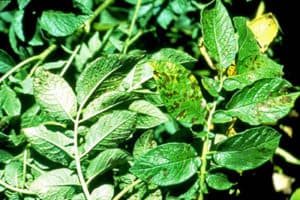How to tell if symptoms mean diseases or nutrition deficiency
Is your crop suffering from a nutrient deficiency or does it have a disease? Sometimes it is difficult to determine the specific ailment just by looking at the plant. Nutritional issues can go undiagnosed as disease symptoms are often very similar, presenting a problem for growers.
In potatoes, for example, curling or stiff leaves can be symptoms of nutrient deficiencies or they can be associated with diseases. Donald Halseth, an associate professor at Cornell University in the Department of Horticulture, says the only way to determine definitively if the plant is lacking a nutrient or is fighting a disease is to have tissue tests conducted.
Specifically, Halseth says potato growers need to be wary of five symptoms that — from their appearance — can be indicative of a disease or nutritional problem. The first is chlorosis, or yellowing of leaves, which can be a symptom of a nitrogen deficiency. Those symptoms also can be an indication of Verticillium wilt, he adds.
Verticillium wilt also may be the culprit for the second symptom: dead plant tissue appearing around the margins of the leaf or the stem. Dead tissue can be the result of plugged plant stems, obstructing the plumbing in the stem and blocking the uptake of nutrients by the plant, explains Halseth.
Lack of new overall growth on the end of the stem also can be a sign of a nutritional need or a virus. Plants not showing new growth can mean there is a calcium or boron deficiency. Leaves of plants that are lacking in these two elements will turn upward, which Halseth says could also mean the plant is suffering from potato leaf roll virus.
“A plant pathologist can tell what the problem is by rubbing his fingers over the surface of the leaves,” explains Halseth. “If [the leaves] have more of a leathery type of feel, it is probably a virus. If the leaves don’t have that feel, then the problem most likely is stress induced or a nutrient deficiency.”
A symptom of a phosphorus deficiency is the accumulation of anthocyanins, which turn leaves a reddish color. Halseth is quick to point out, though, that cool temperatures, maturing plants, or an issue with the plant’s root system also can cause the change in leaf color.
Stunting or reduced plant growth is the fifth symptom. An indication of the problem is a smaller display of leaves. Plant leaves may show normal color, a darker green or yellowing discoloration, which can be a sign of too little zinc. Not common in potatoes, a zinc deficiency also can often be confused with a virus infection, adds Halseth.
The Importance of Testing
As previously mentioned, to avoid confusion and determine if the issue is a deficiency or disease, growers need to have plant tissue tested. Also, it is a good practice to conduct tests to determine the levels of essential nutrients in the soil. Without testing, growers may apply an unnecessary treatment or miss an application of a needed input, unknowingly causing a reduction in yields.
“Tissue analysis tells you what the plant is actually picking up from the soil,” explains Halseth. “Data is available indicating that so many parts per million of the essential elements are needed to be productive. Tissue analysis will tell growers which element is limited and where the problem lies.”
Note, in years of significant drought stress the plant’s root system may not be able to access nutrients from the soil, even when nutrients are available in high levels. Such stress events may produce plant symptoms similar to disease or deficiency problems.
The desired end result for growers is to produce a healthy crop, he concludes. “It is best that you figure out what is causing the problem so you don’t spend money on something that is not the issue.”
If the problem does end up being nutritional deficiency, KeyPlex offers a wide range of products designed for crops from tomatoes, potatoes, carrots, cole crops and more.

